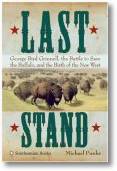By 1902, the US Army estimated that only 23 wild buffalo remained alive in Yellowstone National Park – the pitiful remnants of the massive herds that once blanketed America.
How the buffalo came to teeter on the brink of extinction is the subject of
Last Stand by Michael Punke – a gripping historical account of the eradication of the buffalo and the founding of Yellowstone National Park.
Battle to Save the Buffalo
In
Last Stand, Punke details early conservationist George Bird Grinnell's battle to save both the bison and newly formed Yellowstone Park from hunters and powerful railroad interests.
It opens with a bang; Punke leads with a chilling account of a hunter killing 107 buffalo without leaving his stand, setting the stage for his narrative about the death of the American west.
A better story than most of the fiction I've read, Punke's book focuses on
George Bird Grinnell – a man largely responsible for the conservation of much of the American west, but whom remains mostly unknown today.
Opposing him were all the usual suspects: short-sightedness, a belief that the frontier was infinite, a desire to deal with the "Indian problem," commercial interests, and of course, naked greed.
Wide Ranging NarrativePunke does a commendable job of weaving together the myriad storylines affecting the west, connecting threads from Lewis & Clark to Custer to Bird's battle against congressional inaction in the face of a strong railroad lobby.
George Bird – editor of Forest and Stream magazine – was an early convert to the cause of preserving the American west, and the climax of the book details his last-ditch efforts to preserve the handful of remaining buffalo.
With the help of a US Army Captain fighting a wave of poachers in the park, Bird marshaled his few allies in congress, beat back the railroad lobby (who wanted half of Yellowstone for their own use), and finally – with the help of an outraged public – succeeded in legislating protections against poaching in the National Parks.
The rapid decimation of the buffalo herds is a recurring (and distressing) theme in Punke's book:
"The numbers paint the stark picture at the end. In 1882, the Northern Pacific Railroad alone shipped 200,000 hides to eastern processing facilities, an amount that filled an estimated 700 boxcars. In 1883, the railroad shipped 40,000 hides. In 1884, the total harvest fit in a single boxcar, and according to a Northern Pacific official, 'it was the last shipment ever made.'"
Punke even details the lamentable efforts by many hunters to be the "last to kill a wild buffalo."
Hunters acknowledged the damage done in pursuit of what quickly became a marginal commercial enterprise, but shrugged off the buffalo's impending eradication and decided to get what they could while they could.
Meet the New West; Same as the Old WestIt's impossible to read
Last Stand without drawing some parallels to the perils facing today's parks and wilderness areas – privatization, commercialization, and how to preserve wild game stocks in the face of encroaching domestic stocks.
Today, of course, the Old West is long gone, and the landscape surrounding Yellowstone National Park is populated with cattle, ranches, seasonal towns and hordes of automobile-bound tourists.
It's all the more reason to read Punke's interesting and compelling book, and anyone who has ever read an account of the Lewis & Clark expedition will likely find
Last Stand an outstanding read.
For making history so compelling, I give it two fins up.
Last Stand: George Bird Grinnell, the Battle to Save the Buffalo, and the Birth of the New West
Hardcover: 304 pages
Product Dimensions: 9.1 x 5.9 x 1.2 inches
p.s. -- I updated my "
Review" page to include all my media reviews. Give it a visit and see what you've missed.
last stand, michael punke, buffalo, bison, book review